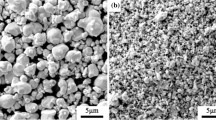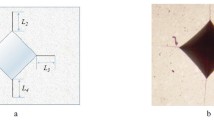Abstract
Doping rare earth elements in WC-Co cemented carbide can make the additives and the original elements form a complex structure, thus further strengthening the overall structure and improving the comprehensive properties of cemented carbide. In this paper, the rare earth element La is added to the cemented carbide WC-Co. Through the construction of atomic cell and interface, the influence of La element on WC-Co cemented carbides is analyzed. The influence law of La atom on other atoms is explained according to analyze the adhesion work, reaction enthalpy, electronic state density and charge density. The results show that more covalent bonds are generated near lanthanum atoms at the interface junction, which enhances the interface bonding strength, makes the whole structure more stable, and the unit cell doped with La element has better stability and improves the overall toughness. The calculation results can provide data for enhancing the performance of cemented carbides and provide a theoretical basis for doping rare earth lanthanum in WC-Co cemented carbides in the future.










Similar content being viewed by others
References
X. Ren, H. Miao, and Z. Peng, A Review of Cemented Carbides for Rock Drilling: An Old but Still Tough Challenge in Geo-Engineering[J], Int. J. Refract. Met. Hard Mater., 2013, 39, p 61–77.
D. Mari, L. Miguel, and C. Nebel, Comprehensive Hard Materials[M], Newnes, Oxford, 2014.
S.A. Johansson and G. Wahnström, Theory of Ultrathin Films at Metal–Ceramic Interfaces[J], Philos. Mag. Lett., 2010, 90(8), p 599–609.
V. Pugsley and C. Allen, Microstructure/Property Relationships in the Cavitation Erosion of Tungsten Carbide–Cobalt[J], Wear, 1999, 233, p 93–103.
C. Xu, X. Ai, and C. Huang, Research and Development of Rare-Earth Cemented Carbides[J], Int. J. Refract. Met. Hard Mater., 2001, 19(3), p 159–168.
Z. Li, W. Zhao, D. Zhang et al., Influence of Rare-Earth Element Doping on Interface and Mechanical Properties of WC Particles Reinforced Steel Matrix Composites[J], Mater. Res. Express, 2021, 8(3), p 036512.
C. Marques, G. Bobrovnitchii, and J. Holanda, High Pressure Sintering of WC-10Co Doped with Rare-Earth Elements, Sintering of Ceramics—New Emerging Techniques, 2012, p 379–398.
X. Ou, D. Xiao, T. Shen et al., Characterization and Preparation of Ultra-Fine Grained WC-Co Alloys with Minor La-Additions[J], Int. J. Refract. Met. Hard Mater., 2012, 31, p 266–273.
W. Shao, Y. Zhou, L. Rao, X. Xing, Z. Shi, and Q. Yang, Effect of Cr Doping on Interface Properties of DLC/CrN Composite Coatings: First-Principles Study, Diam. Relat. Mater., 2022, 121, p 108721.
J. Hu, X. Jian, T. Yang, and X. Peng, Investigation on the Interface Characteristic Between WC(001) and Diamond(111) by First-Principles Calculation, Diam. Relat. Mater., 2022, 123, p 08864.
Z.H. Li, J.L. Feng, Z.X. Wu, M.J. Pang, D. Liu, W.C. Yang, and Y.Z. Zhan, The Stability and Electronic Structure of Cu(2 0 0)/AuCu(2 0 0) Interface: An Insight from First-Principle Calculation, Materials, 2022, 15, p 1506.
C. Allibert, Sintering Features of Cemented Carbides WC-Co Processed from Fine Powders[J], Int. J. Refract. Met. Hard Mater., 2001, 19(1), p 53–61.
J.-M. Missiaen, Solid-State Spreading and Sintering of Multiphase Materials[J], Mater. Sci. Eng. A, 2008, 475(1–2), p 2–11.
A. Yang, Y. Duan, and M. Peng et al., Revealing the Interface Characteristic of the Semi-Coherent Co (111)/WC (0001) Interface: A First Principles Investigation[J], Philos. Mag., 2022, 102, p 1–25.
Z.P. Hao, Y. Qiu, Y.H. Fan et al., Theoretical Calculation and Analysis of New Rare Earth Cemented Carbide Based on First-Principles[J], Int. J. Refract. Met. Hard Mater., 2021, 101, p 105688.
J.P. Perdew, K. Burke, and M. Ernzerhof, Generalized Gradient Approximation Made Simple[J], Phys. Rev. Lett., 1996, 77(18), p 3865.
M. Christensen and G. Wahnström, Effects of Cobalt Intergranular Segregation on Interface Energetics in WC-Co[J], Acta Mater., 2004, 52(8), p 2199–2207.
J.P. Perdew and Y. Wang, Erratum: Accurate and Simple Analytic Representation of the Electron-Gas Correlation Energy [J], Phys. Rev. B, 2018, 98(7), p 079904.
H.J. Monkhorst and J.D. Pack, Special Points for Brillouin-Zone Integrations[J], Phys. Rev. B, 1976, 13(12), p 5188.
G. Kresse and J. Furthmüller, Efficient Iterative Schemes for ab Initio Total-Energy Calculations Using a Plane-Wave Basis Set[J], Phys. Rev. B, 1996, 54(16), p 11169.
B.G. Pfrommer, M. Côté, S.G. Louie et al., Relaxation of Crystals with the Quasi-Newton Method[J], J. Comput. Phys., 1997, 131(1), p 233–240.
V.G. Zavodinsky, Cobalt Layers Crystallized on the WC (100) Surface: Spin-Polarized ab Initio Study[J], Int. J. Refract. Met. Hard Mater., 2011, 29(2), p 184–187.
X. Zhao, Y. Zhuo, S. Liu et al., Investigation on WC/TiC Interface Relationship in Wear-Resistant Coating by First-Principles[J], Surf. Coat. Technol., 2016, 305, p 200–207.
Na. Jin, Y. Yang, J. Li, X. Luo, B. Huang, Q. Sun, and P. Guo, First-Principles Calculation on Î2-SiC (1 1 1) /α-WC (0 0 0 1) Interface[J], J. Appl. Phys., 2014, 115(22), p 5811–5836.
J. Yang, Z. Ye, J. Huang et al., First-Principles Calculations on Wetting Interface Between Ag-Cu-Ti Filler Metal and SiC Ceramic: Ag (1 1 1)/SiC (1 1 1) Interface and Ag (1 1 1)/TiC (1 1 1) Interface[J], Appl. Surf. Sci., 2018, 462, p 55–64.
M. Christensen, S. Dudiy, and G. Wahnström, First-Principles Simulations of Metal-Ceramic Interface Adhesion: Co/WC vs. Co/TiC[J], Phys. Rev. B, 2002, 65(4), p 045408.
J.R. Yang, B.F. Ren, and S.L. Li, Effect of SiC Interlayer on Interfacial Adhesion of Diamond Coated Cemented Carbide Tool Film Base [J], J. Synth. Cryst., 2019, 48(3), p 428–435. ((In Chinses))
H. Chen, L. Yang, and J. Long, First-Principles Investigation of the Elastic, Vickers Hardness and Thermodynamic Properties of Al-Cu Intermetallic Compounds[J], Superlattices Microstruct., 2015, 79, p 156–165.
Z.-J. Wu, E.-J. Zhao, H.-P. Xiang et al., Crystal Structures and Elastic Properties of Superhard IrN2 and IrN3 from First Principles[J], Phys. Rev. B, 2007, 76(5), p 054115.
R. Hill, The Elastic Behaviour of a Crystalline Aggregate[J], Proc. Phys. Soc. Sect. A, 1952, 65(5), p 349.
E.J. Zhao and H.P. Xiang, Crystal Structures and Elastic Properties of Superhard IrN2 and IrN3 from First Principles [J], Phys. Rev. B, 2007, 76(5), p 054115.
Y. Li, Y. Gao, B. Xiao et al., The Electronic, Mechanical Properties and Theoretical Hardness of Chromium Carbides by First-Principles Calculations[J], J. Alloys Compd., 2011, 509(17), p 5242–5249.
S. Pugh, Relations Between the Elastic Moduli and the Plastic Properties of Polycrystalline Pure Metals[J], Lond. Edinb. Dublin Philos. Mag. J. Sci., 1954, 45(367), p 823–843.
Acknowledgments
This work is supported by National Natural Science Foundation of China (52275404), Natural Science Foundation of Jilin Province (YDZJ202301ZZYTS484), Key industrial technology research project of Jilin Province (20210201043GX), Project of Science and Technology Bureau of Changchun City, Jilin Province (21ZY40). This work is also supported by Key Laboratory for International Cooperation in High-performance Manufacturing and Testing of Jilin Province (20220502003GH), and Key Laboratory of Micro/Nano and Ultra-Precision Manufacturing of Jilin Province (20140622008JC)
Author information
Authors and Affiliations
Corresponding author
Ethics declarations
Conflicts of interest
The authors declare no competing interests.
Ethical Approval
This article does not contain any studies with human participants or animals performed by any of the authors.
Additional information
Publisher's Note
Springer Nature remains neutral with regard to jurisdictional claims in published maps and institutional affiliations.
Rights and permissions
Springer Nature or its licensor (e.g. a society or other partner) holds exclusive rights to this article under a publishing agreement with the author(s) or other rightsholder(s); author self-archiving of the accepted manuscript version of this article is solely governed by the terms of such publishing agreement and applicable law.
About this article
Cite this article
Fan, Y., Wang, W. & Hao, Z. Theoretical Calculation and Analysis of Physical and Mechanical Properties of WC-Co Cemented Carbide with Lanthanum. J. of Materi Eng and Perform 33, 3582–3591 (2024). https://doi.org/10.1007/s11665-023-08246-0
Received:
Revised:
Accepted:
Published:
Issue Date:
DOI: https://doi.org/10.1007/s11665-023-08246-0




